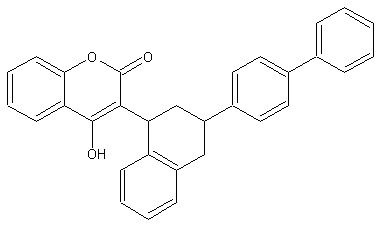Difenacoum does not occur naturally. It is used as a rodenticide against pest rodents and acts by preventing the production of blood clotting factors. It is an off-white powder. Its solubility in water is very low (less than 10 mg/litre at 20°C and pH 7). It is slightly soluble in benzene, and soluble in acetone and chloroform. It is a weak acid, but its sodium and potassium salts are sparingly soluble in water. Difenacoum does not enter the atmosphere, because of its low volatility. It is practically insoluble in water. Difenacoum is bound to soil particles and is not taken up by plants. The rate of degradation is relatively slow and depends on soil type. Residues in crops have never been detected in field studies. Difenacoum is not intended for direct application to growing crops or for use as a food additive.Difenacoum is absorbed through the gastrointestinal tract, skin, and respiratory system. The major route of elimination in different species, after oral administration, is via the faeces. The liver is the main organ of accumulation and storage. Difenacoum has been found in the liver as both the parent compound and metabolites. The metabolism and elimination of the trans-isomer was more rapid than those of the cis-isomer. The elimination from the liver and kidney is biphasic with an initial rapid phase of three days and a slower phase with a half-life of 118-120 days. In the pancreas, the concentration declined more slowly (a half-life of 182 days). No data are available for the kinetics and metabolism of difenacoum in humans. Difenacoum is not a skin or eye irritant.
Chemical Name: 3-(3-biphenyl-4-yl-1,2,3,4-tetrahydro-1-naphthyl)-4-hydroxycoumarin
Chemical Formula: C31H24O3
Chemical Structure:
LD50/LC50: The acute oral toxicity of difenacoum is high, i.e., LD50's of 1.8 and 2 mg/kg body weight for rats and rabbits, respectively, and between 50 and 100 mg/kg body weight for various non-rodent mammals. The acute dermal LD50 is greater than 50 mg/kg body weight in rats and rabbits. Signs of poisoning are those associated with an increased tendency to bleed. In repeated oral feeding studies on mammals, the only effect was that associated with anticoagulant action. No long-term studies have been carried out. No experimental evidence is available to conclude the absence of mutagenicity and teratogenicity. The main features of difenacoum poisoning in less severe cases are excessive bruising, nose and gum bleeding, and blood in the urine and faeces. Bleeding from several organs within the body, leading to shock and possibly death, occurs in the more severe cases. The onset of the signs of poisoning may not be evident until a few days after ingestion.
Environmental Considerations: Difenacoum is applied to discrete sites in the form of low-concentration baits. It is stable under normal conditions. Difenacoum is slightly soluble in water and in bait formulation it is unlikely to be a source of water pollution.The toxic concentrations for fish far exceed any level of difenacoum that could be expected to occur in accidental contamination of water during normal usage.
Non-target organisms are potentially at risk through direct consumption of baits (primary hazard) and through eating poisoned rodents (secondary hazard).
Bird species appear to be less susceptible to difenacoum than rodents. Small pellets and whole grain baits are highly attractive to birds.
The primary hazard is usually expressed by the amount of finished bait that must be consumed to approach the lethal dose. To reach the toxic or lethal dose, the non-target species must consume comparatively large amounts of bait with a concentration of 0.005% active ingredient.
Some secondary toxicity laboratory studies on wildlife have shown that captive predators could be intoxicated by no-choice feeding of difenacoum-poisoned or dosed prey. The significance of these results in terms of hazard under field conditions is difficult to assess, because the predators would not be expected to eat only poisoned animals. However, predators may take poisoned, but not dead, small mammals preferentially. In areas close to baiting, poisoned rodents may represent a high proportion of the diet for individual birds. However, only few individuals will be affected, unless there is very widespread and constant use of the baits.
Advice to physicians: If poisoning has occurred recently (within a few hours), gastric lavage and repeated administration of charcoal is recommended. A venous blood sample should be taken to measure the haemoglobin level, prothrombin time, blood grouping, and cross-matching.
If a patient is bleeding severely, 25 mg of vitamin K1 (phytomenadione) should be given by slow intravenous injection. The patient should be transfused with whole blood or plasma. Fresh, frozen plasma may be given. Prothrombin time should be checked at 3-h intervals and injections of vitamin K1 repeated, if no improvement occurs.
In less severe cases of poisoning, vitamin K1 may be given in lower doses, together with fresh, frozen plasma to rapidly restore the blood clotting factors. Prothrombin time should be checked after 8-10 h and vitamin K1 administration repeated, if necessary. Oral treatment may be sufficient in minor cases.
Once the prothrombin time has stabilized, vitamin K1 (10 mg) should be administered orally, four times daily. The patient should be kept in hospital until the prothrombin time has remained normal for three days.
The patient should be discharged from hospital with the following treatment: vitamin K1 orally (10 mg) twice daily, for up to 60 days, with close monitoring of the prothrombin time. It may be possible to reduce the length of treatment.
